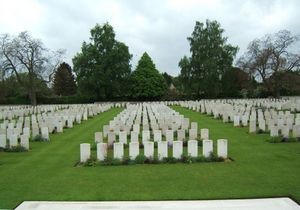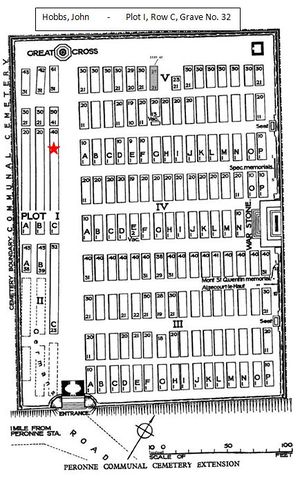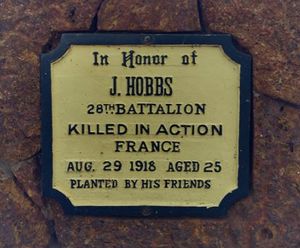Difference between revisions of "John Hobbs"
From Our Contribution
| Line 72: | Line 72: | ||
1915 Electoral Roll entry - farm hand at "Mill Lane Farm" Beenup. | 1915 Electoral Roll entry - farm hand at "Mill Lane Farm" Beenup. | ||
| + | ==War Service== | ||
| + | Following six weeks general training with the 11th Depot Company, Fred was allocated to 'C' Company of the [[28th Battalion]] that was being raised in Western Australia at that time. Completing his Australian training, he travelled with them to Egypt aboard [[HMAT A11 Ascanius]] departing from Fremantle on 9 Jun 1915, and arriving off Suez on the 30th before disembarking on the morning of 2 Jul 1915. In addition to training they also spent a month on Garrison duty at the 'Citadel'. On 3 Sep 1915 the battalion entrained for Alexandria where they boarded the [[HMT Ivernia]] for Mudros harbour on Lemnos Island. Although they arrived on 4 Sep 1915, it was not until 10 Sep 1915 when they transshipped to the [[HMT Sarnia]] which carried them to the Gallipoli Peninsula 100 kilometers away. | ||
| + | |||
| + | John served on the Gallipoli Peninsular from early September 1915 until the evacuation in December. (The 28th Battalion less some of its machine gunners were evacuated to Mudros aboard [[HMS Osmanieh]] at 6:00am 13 Dec 1915. John arrived back in Alexandria from Mudros aboard [[HMT Ausonia]] on 9 Jan 1916 (disembarked on the 10th). The Ausonia had left Mudros harbour early on 6 Jan 1916. Following a rebuild and some training, the battalion was then sent on to Marseilles in France via Alexandria aboard [[HMAT A32 Themistocles]] from 16 - 21 March 1916. John was admitted to hospital between 3 and 6 May 1916 with influenza. | ||
| − | |||
| − | |||
| − | |||
| − | |||
| − | At the second Bullecourt battle on 3 May 1917 John would have been engaged in fighting along the OG1 and OG2 trenches using grenades (bombs) as his unit and others before them had repeatedly bombed their way along trenches capturing them, only to be pushed back by strong counterattacks. This happened 5 or 6 times, with the 28th Battalion engaged in the 4th and subsequent phases. During one of these phases John received a GSW to his left arm. Treated first by the 5th | + | At the second Bullecourt battle on 3 May 1917 John would have been engaged in fighting along the OG1 and OG2 trenches using grenades (bombs) as his unit and others before them had repeatedly bombed their way along trenches capturing them, only to be pushed back by strong counterattacks. This happened 5 or 6 times, with the 28th Battalion engaged in the 4th and subsequent phases. During one of these phases John received a GSW to his left arm. Treated first by the [[5th Field Ambulance]], he was then treated by the [[3rd Australian Casualty Clearing Station]] on 3 & 4 May before being evacuated via [[Ambulance Train]] to the 5th General Hospital in Rouen from 4 - 17 May 1917. John was evacuated to England from Rouen on 17 May 1917 aboard the [[HMHS Aberdonian]], and admitted on 18 May 1917 to 1st Southern General Hospital at Stirchley (near Birmingham) for treatment until 5 Jun 1917 for what was then described as a severe wound to his left shoulder. |
| + | |||
| − | Discharged on 21 May 1917 he was granted furlough until 5 Jun 1917 when he reported to the No. 1 Command Depot at [[Perham Downs]]. On 15 Aug 1917 he transferred to the Overseas Training Brigade which was at that time also located at [[Perham Downs]]. While waiting to go back to France he was AWOL for 16 days from 6:30am on 18 Aug 1917 until he was placed in detention at 10:00pm on 4 Sep 1917. John was awarded 28 days detention and forfeited 48 days pay. John proceeded overseas to France on 10 Sep 1917 through Southampton aboard the [[HMHS Aberdonian]]. | + | Discharged on 21 May 1917 he was granted furlough until 5 Jun 1917 when he reported to the No. 1 Command Depot at [[Perham Downs]]. On 15 Aug 1917 he transferred to the [[Overseas Training Brigade]] which was at that time also located at [[Perham Downs]]. While waiting to go back to France he was AWOL for 16 days from 6:30am on 18 Aug 1917 until he was placed in detention at 10:00pm on 4 Sep 1917. John was awarded 28 days detention and forfeited 48 days pay. John proceeded overseas to France on 10 Sep 1917 through Southampton aboard the [[HMHS Aberdonian]]. In France he rejoined the 28th Battalion rear detail on 20 Sep 1917 while the battalion was involved in the Battle for Menin Road, and he rejoined the battalion proper on 29 Oct 1917. |
| − | |||
John was wounded in action for the second time on 4 Oct 1917 at Broodseinde with a GSW to his thigh, when he was one of the day's heavy casualties (6 Officers wounded, 42 ORs KIA, 85 WIA, and 5 Missing). [Neville Bowning's ''The Blue & White Diamond'' put the losses at one officer and 45 other ranks killed and eight officers and 102 other ranks wounded since 1 Oct 1917.]<ref>Neville Browning. The Blue & White Diamond, page 320. Advance Press</ref> Admitted to the 17th Casualty Clearing Station on 7 Oct 1917, he entered the 14th General Hospital at Boulogne the next day for two days before being released to the 1st Convalescent Depot on 10 Oct 1917. John rejoined the battalion on 29 Oct 1917. | John was wounded in action for the second time on 4 Oct 1917 at Broodseinde with a GSW to his thigh, when he was one of the day's heavy casualties (6 Officers wounded, 42 ORs KIA, 85 WIA, and 5 Missing). [Neville Bowning's ''The Blue & White Diamond'' put the losses at one officer and 45 other ranks killed and eight officers and 102 other ranks wounded since 1 Oct 1917.]<ref>Neville Browning. The Blue & White Diamond, page 320. Advance Press</ref> Admitted to the 17th Casualty Clearing Station on 7 Oct 1917, he entered the 14th General Hospital at Boulogne the next day for two days before being released to the 1st Convalescent Depot on 10 Oct 1917. John rejoined the battalion on 29 Oct 1917. | ||
| + | |||
| + | |||
| + | The battalion's War Diary described 24 Apr 1918 as a "dry but dull day". Although in the reserve lines near Villers-Bretonneux, John was WIA for the 3rd time by a retaliatory German artillery barrage. He suffered a severe shell wound to his right knee and abdomen wall. Treated by the [[6th Field Ambulance]] that day and by the 4th Casualty Clearing Station the next day, he entered the 9th General Hospital in Rouen on 25 Apr 1917. On 27 Apr 1917 he was again evacuated to England, this time on [[HMHS St Patrick]], and was admitted to 1st Southern General Hospital at Birmingham on 28 Apr 1918. Discharged from hospital, he spent 6 - 20 Jun 1918 in a convalescent depot. | ||
| + | |||
| − | |||
| − | |||
Arriving back in France on 3 Aug 1918 via Folkestone, he rejoined the 28th Battalion on 11 Aug 1918, and then on the 29th August 1918 his luck finally ran out when he was Killed in Action near Biaches Wood at Flaucourt during the advance up the Somme River. The Battalion War diary entry for the day includes "The casualties were exceedingly light on our side." | Arriving back in France on 3 Aug 1918 via Folkestone, he rejoined the 28th Battalion on 11 Aug 1918, and then on the 29th August 1918 his luck finally ran out when he was Killed in Action near Biaches Wood at Flaucourt during the advance up the Somme River. The Battalion War diary entry for the day includes "The casualties were exceedingly light on our side." | ||
| Line 98: | Line 100: | ||
==Notes== | ==Notes== | ||
| − | |||
Mentioned in the 1917 Feb-Mar edition of ''The Drill of the Foot-Hills'', but no detail given. | Mentioned in the 1917 Feb-Mar edition of ''The Drill of the Foot-Hills'', but no detail given. | ||
| Line 111: | Line 112: | ||
[[Category:Soldier]] | [[Category:Soldier]] | ||
| − | |||
[[Category:1917 WIA]] | [[Category:1917 WIA]] | ||
[[Category:1918 WIA]] | [[Category:1918 WIA]] | ||
Revision as of 01:16, 23 June 2021
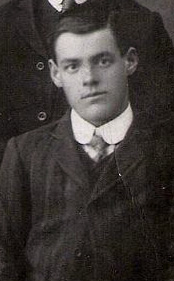 courtesy arrowsmith33 @ ancestry.com.au | |
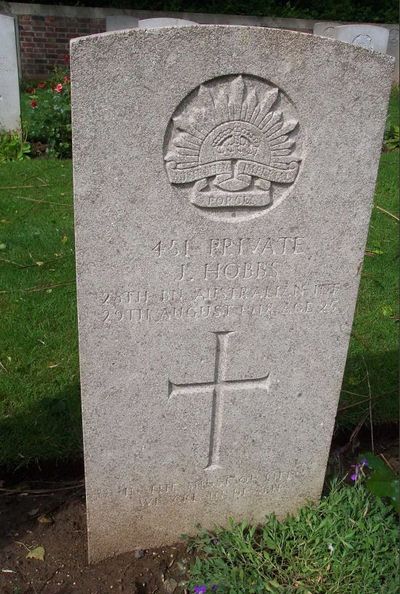 | |
| Personal Information | |
|---|---|
| Date of Birth | 28 Oct 1893 |
| Place of Birth | Bidderford, Devonshire, England |
| Death | 29 Aug 1918 |
| Place of Death | Albert, France |
| Age at Enlistment | 22 years, 5 months |
| Description |
5'5¾" (1.67m) tall ; 136 lbs 61.689 kg ; dark complexion ; brown eyes ; dark hair |
| Occupation | Farm labourer |
| Religion | Presbyterian |
| Address | 'Mill Lane Farm', Beenup, Western Australia |
| Next of Kin | Father , Mr Thomas Heard Hobbs |
| Military Information | |
| Reg Number | 451 |
| Date of Enlistment | 8 Mar 1915 |
| Rank | Private |
| Unit/Formation | 28th Battalion, C Company / 7th Brigade, 2nd Division |
| Date of Embarkation | 9 Jun 1915 ‒ 30 Jun 1915 |
| Ship Embarked On | HMAT A11 Ascanius |
| Fate |
Wounded in Action 3 May 1917 2nd Bullecourt Wounded in Action 4 Oct 1917 Broodseinde Wounded in Action 24 Apr 1918 Villers-Bretonneux Killed in Action 29 Aug 1918 Flaucourt, France |
| Monument |
Armadale War Memorial (Beenup panel) Armadale and Districts Roll of Honour Australian War Memorial |
| Medals |
1914-15 Star British War Medal Victory Medal |
Contents
Pre War
1915 Electoral Roll entry - farm hand at "Mill Lane Farm" Beenup.
War Service
Following six weeks general training with the 11th Depot Company, Fred was allocated to 'C' Company of the 28th Battalion that was being raised in Western Australia at that time. Completing his Australian training, he travelled with them to Egypt aboard HMAT A11 Ascanius departing from Fremantle on 9 Jun 1915, and arriving off Suez on the 30th before disembarking on the morning of 2 Jul 1915. In addition to training they also spent a month on Garrison duty at the 'Citadel'. On 3 Sep 1915 the battalion entrained for Alexandria where they boarded the HMT Ivernia for Mudros harbour on Lemnos Island. Although they arrived on 4 Sep 1915, it was not until 10 Sep 1915 when they transshipped to the HMT Sarnia which carried them to the Gallipoli Peninsula 100 kilometers away.
John served on the Gallipoli Peninsular from early September 1915 until the evacuation in December. (The 28th Battalion less some of its machine gunners were evacuated to Mudros aboard HMS Osmanieh at 6:00am 13 Dec 1915. John arrived back in Alexandria from Mudros aboard HMT Ausonia on 9 Jan 1916 (disembarked on the 10th). The Ausonia had left Mudros harbour early on 6 Jan 1916. Following a rebuild and some training, the battalion was then sent on to Marseilles in France via Alexandria aboard HMAT A32 Themistocles from 16 - 21 March 1916. John was admitted to hospital between 3 and 6 May 1916 with influenza.
At the second Bullecourt battle on 3 May 1917 John would have been engaged in fighting along the OG1 and OG2 trenches using grenades (bombs) as his unit and others before them had repeatedly bombed their way along trenches capturing them, only to be pushed back by strong counterattacks. This happened 5 or 6 times, with the 28th Battalion engaged in the 4th and subsequent phases. During one of these phases John received a GSW to his left arm. Treated first by the 5th Field Ambulance, he was then treated by the 3rd Australian Casualty Clearing Station on 3 & 4 May before being evacuated via Ambulance Train to the 5th General Hospital in Rouen from 4 - 17 May 1917. John was evacuated to England from Rouen on 17 May 1917 aboard the HMHS Aberdonian, and admitted on 18 May 1917 to 1st Southern General Hospital at Stirchley (near Birmingham) for treatment until 5 Jun 1917 for what was then described as a severe wound to his left shoulder.
Discharged on 21 May 1917 he was granted furlough until 5 Jun 1917 when he reported to the No. 1 Command Depot at Perham Downs. On 15 Aug 1917 he transferred to the Overseas Training Brigade which was at that time also located at Perham Downs. While waiting to go back to France he was AWOL for 16 days from 6:30am on 18 Aug 1917 until he was placed in detention at 10:00pm on 4 Sep 1917. John was awarded 28 days detention and forfeited 48 days pay. John proceeded overseas to France on 10 Sep 1917 through Southampton aboard the HMHS Aberdonian. In France he rejoined the 28th Battalion rear detail on 20 Sep 1917 while the battalion was involved in the Battle for Menin Road, and he rejoined the battalion proper on 29 Oct 1917.
John was wounded in action for the second time on 4 Oct 1917 at Broodseinde with a GSW to his thigh, when he was one of the day's heavy casualties (6 Officers wounded, 42 ORs KIA, 85 WIA, and 5 Missing). [Neville Bowning's The Blue & White Diamond put the losses at one officer and 45 other ranks killed and eight officers and 102 other ranks wounded since 1 Oct 1917.][1] Admitted to the 17th Casualty Clearing Station on 7 Oct 1917, he entered the 14th General Hospital at Boulogne the next day for two days before being released to the 1st Convalescent Depot on 10 Oct 1917. John rejoined the battalion on 29 Oct 1917.
The battalion's War Diary described 24 Apr 1918 as a "dry but dull day". Although in the reserve lines near Villers-Bretonneux, John was WIA for the 3rd time by a retaliatory German artillery barrage. He suffered a severe shell wound to his right knee and abdomen wall. Treated by the 6th Field Ambulance that day and by the 4th Casualty Clearing Station the next day, he entered the 9th General Hospital in Rouen on 25 Apr 1917. On 27 Apr 1917 he was again evacuated to England, this time on HMHS St Patrick, and was admitted to 1st Southern General Hospital at Birmingham on 28 Apr 1918. Discharged from hospital, he spent 6 - 20 Jun 1918 in a convalescent depot.
Arriving back in France on 3 Aug 1918 via Folkestone, he rejoined the 28th Battalion on 11 Aug 1918, and then on the 29th August 1918 his luck finally ran out when he was Killed in Action near Biaches Wood at Flaucourt during the advance up the Somme River. The Battalion War diary entry for the day includes "The casualties were exceedingly light on our side."
Notes
Mentioned in the 1917 Feb-Mar edition of The Drill of the Foot-Hills, but no detail given.
- ↑ Neville Browning. The Blue & White Diamond, page 320. Advance Press
